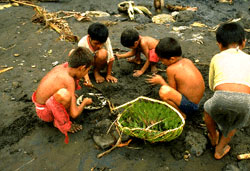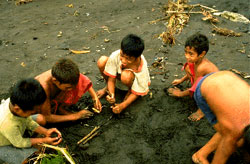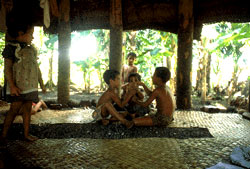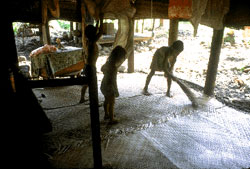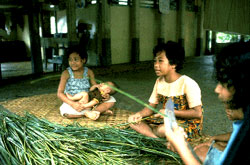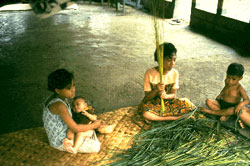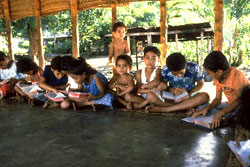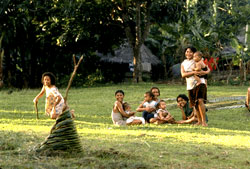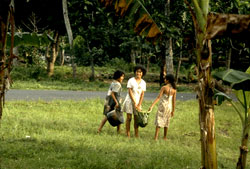|
Children's Space in Samoa Kids playing on a beach: In the Spring of 1981, Elinor Ochs and I went back to the village of Falefa, in Western Samoa, to do some more fieldwork and collect images of children's activities (we were sponsored by the Research School of Pacific Studies at the Australian National University). One morning, as we were going to meet a family in another part of the village to film their daily activities, we noticed a group of young kids playing on the beach. We stopped and started film their interaction. When I ran out of Sound Super 8 film, I took some slides. This is one of them.
I remember that when we arrived at the site where the kids were playing, they stopped their game and started to interact with us. I told them to go back to what they were doing but they seemed unable to return to their game. They were staring at us, schocked by our attention to them and probably curious about our cameras and tape recorder. I then started to imitate the way they had been talking while playing, mocking their intonation and phrasing. That did it. They slowly went back to their fantasy game made up of trucks delivering cement, people getting coconuts, preparing the fire, collecting garbage, and making 'vaisalo' (coconut purridge). I filmed them for over 10 continuous minutes from a few feet away, while Elinor was holding the microphone, trying to protect it from the strong wind.
Kids playing inside house: This is another playing activity we filmed in 1981. These three boys are playing one of their favorite games inside the house while their younger sister and one of their neighbors are watching them. This activity has the flavor of being supervised by adults. The kids are sitting on mats in the center of the house, as if on certer stage.
Kids sweeping a house: In Western Samoa, boys and girls routinely participate in household chores. In this picture, two boys and a girl are engaged in cleaning up their 'fale' (house). The floor is completely covered by 'fala' (mats) and they are sweeping away dirt and little rocks. The absence of objects on the floor and the paucity of furniture is typical of traditional Samoan households, where most items are stored under the roof, between beams, and the curtains sometimes used to separate different sleeping spaces during the night are lifted in the morning.
Childcare while working: In the Spring of 1981, we spent several days at the house compound of the orator Leuta, in the subvillage of Sanonu, in Falefa. The entire family was engaged in the task of rebuilding one of their 'fale Samoa' (Samoan-style houses). While the men were cutting and lifting the wooden posts, the women were preparing new 'pola' (screens) and a new thatched roof. The children in the meantime were also helping. In this picture, young girls sit in the main house of the compound making brooms while baby sitting their younger siblings.
Kids at pastor's school: School instruction was one of the activities Elinor Ochs and I were interested in documenting in 1981 (see our article reproduced in Ochs, Culture and Language Development, ch. 10). We filmed two settings: the local Catholic school and the local pastor's school, where children learn to read and interpret the Bible. In this context, the children dress and act quite differently from other situations in their daily life. The presence of books (mostly the Bible) is only one of the elements that enters into the constitution of the activity as distinct.
Childcare and play: This is a picture I took in the late afternoon of a group of older children taking care of infants and enjoying each other. Given that older children are usually in school in the morning, groups of caregivers tend to form in the afternoon. This scene is a good reminder of the fact that in real life activities interpenetrate each other. In this case, these girls are caring for their younger siblings and enjoying each other telling stories and playing games. The participation in these activities is a primary context for language socialization (see Elinor Ochs, Culture and Language Development, Cambridge UP, 1988).
Stopping to exchange news: Another moment of children's life. In the afternoon, older children are sent off to fetch food, borrow utensils from relatives, or wash clothes. These tasks occupy their time away from school with chores rather than playful activities but also give them an opportunity to walk from one end of the village to the other, meet some of their peers and more distant relatives, and find out about the latest news. This picture shows two girls carrying a basket with food and a girl with a large pot chatting on the side of the main road before returning to their respective family compounds.
|
